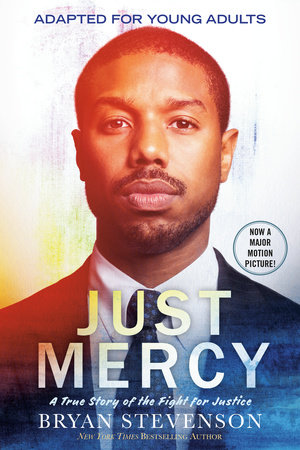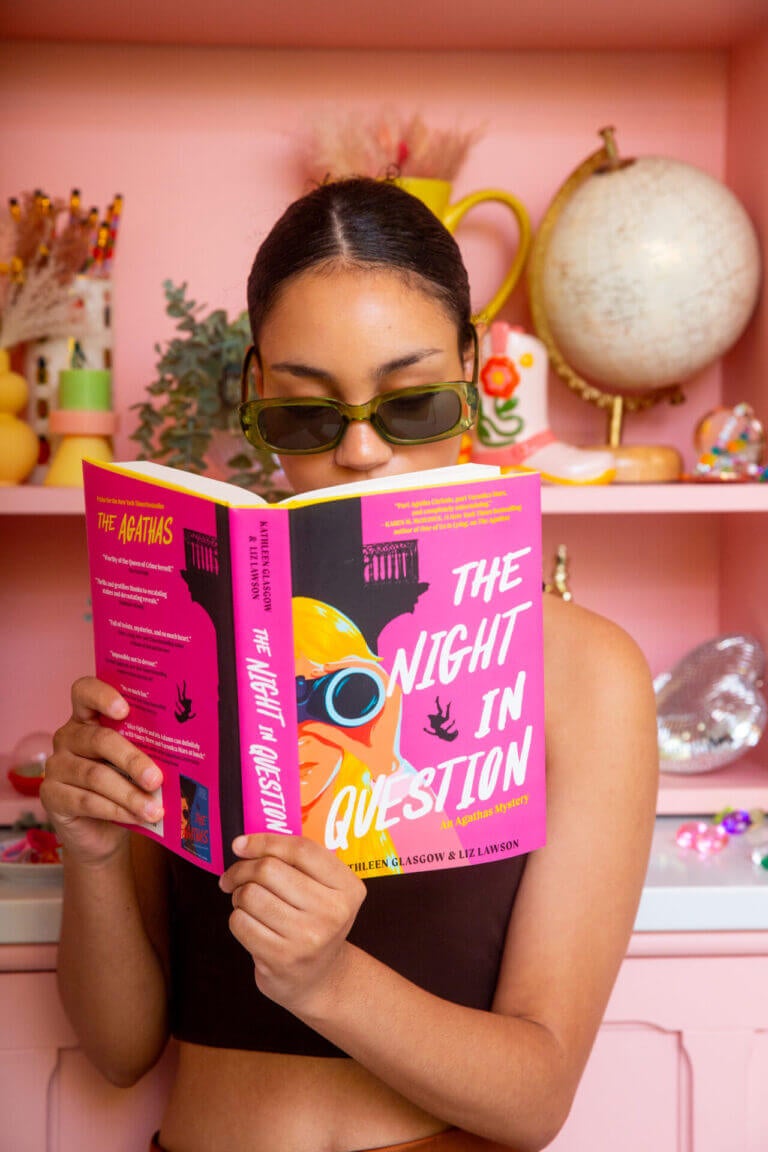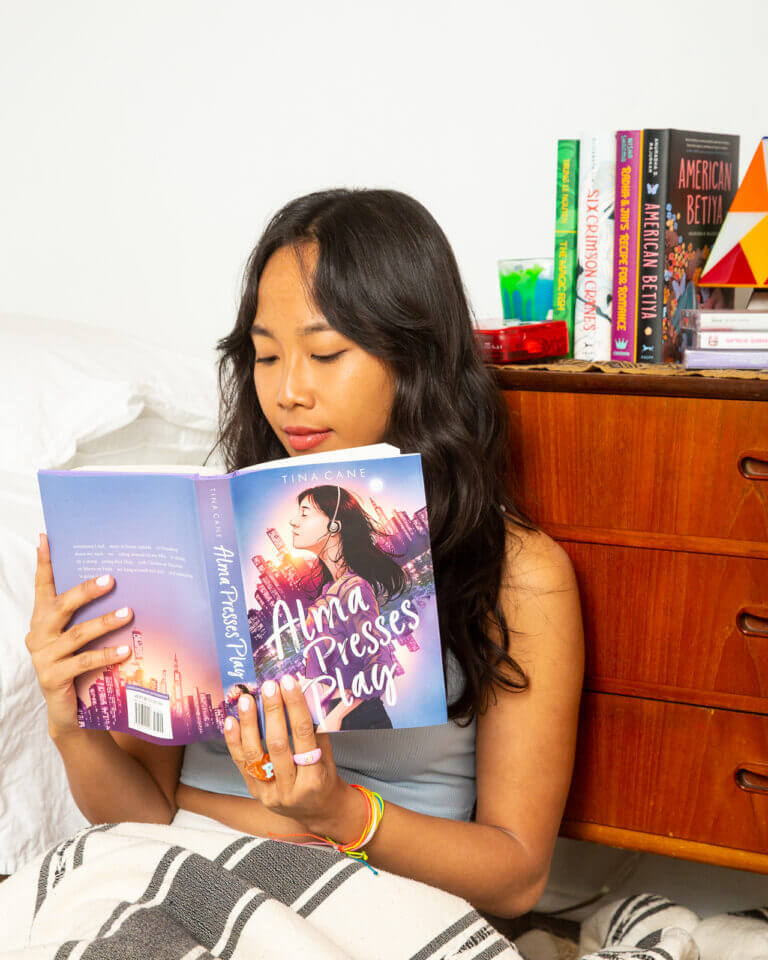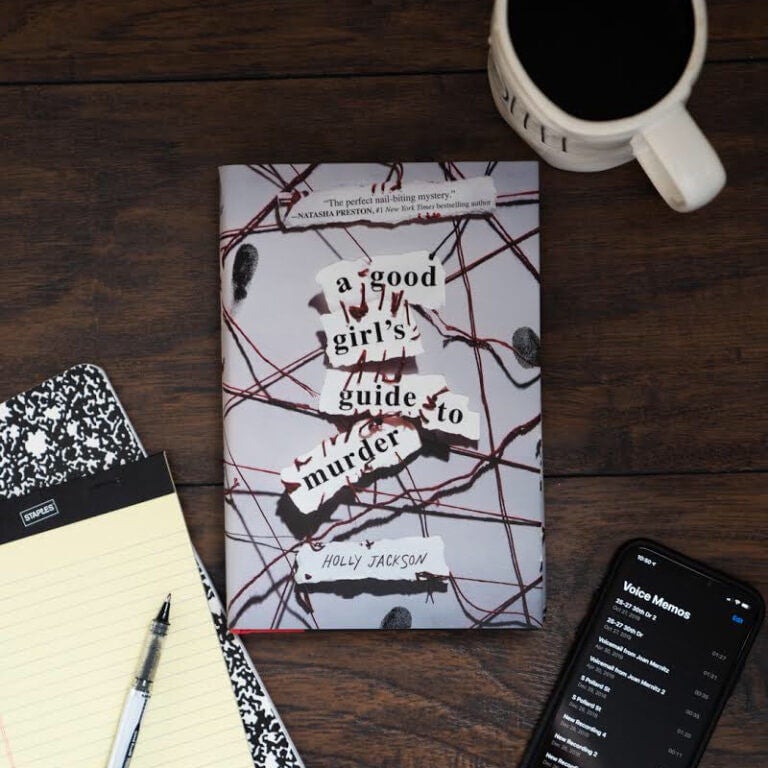One of our favorite Book Nerd activities is going to book club! Book clubs create community, help us get through our TBR pile, discover new faves, and allow space to talk about our favorite characters. To help with your book club endeavors, we’ve created book club guides for some of our favorite YA titles. This Just Mercy (Adapted for Young Adults) book club guide will help you get the most out of reading Bryan Stevenson’s bestselling book. Dive into these discussion questions, and don’t forget to watch the movie starring Michael B. Jordan, Jaime Foxx, and Brie Larson.
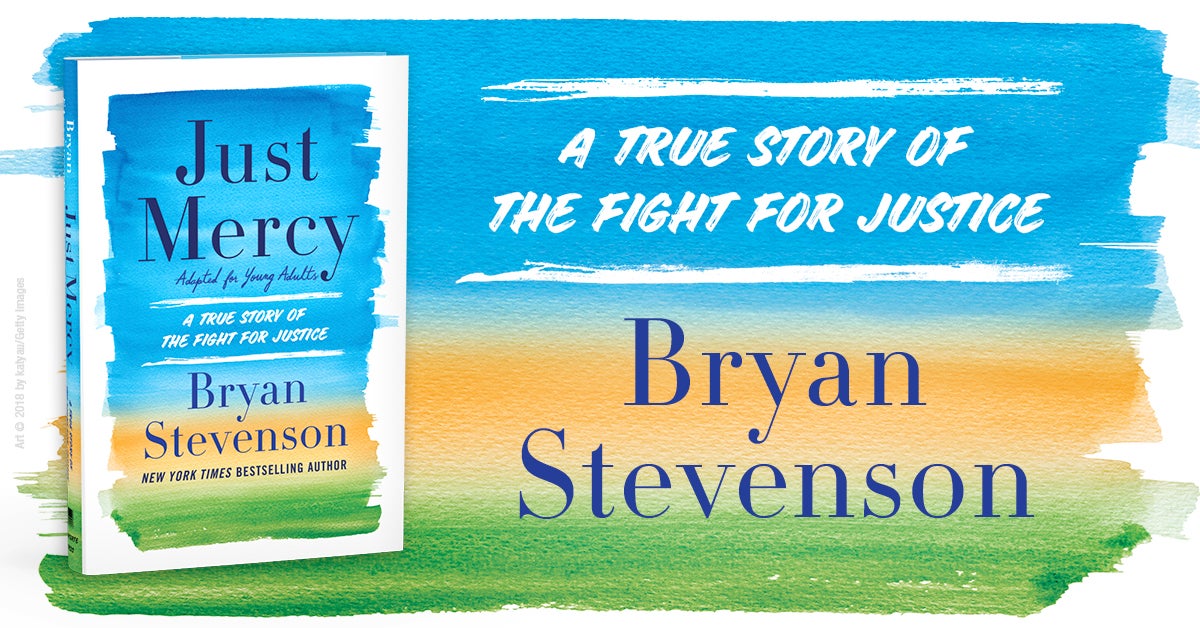
Just Mercy Book Club Guide Discussion Questions
The Criminal Justice System
- After working with low-income and incarcerated people for many years, Bryan Stevenson came to believe that “the opposite of poverty is not wealth; the opposite of poverty is justice.” How do you see poverty affecting people’s lives in Just Mercy? Are there any examples of poverty and justice coexisting? What are some of the different meanings of the word just in the book? What is your definition of justice?
- As you read the book, what were your reactions to Bryan’s descriptions of the criminal justice system? Why does he compare his own brokenness to the brokenness of the system? Do you believe that broken people can be healed? What does it mean to show mercy within a broken system? What would happen if we all acknowledged our brokenness?
- Were you surprised by the prevalence of improper legal representation in the cases profiled in Just Mercy? What examples of discriminatory jury selection does Bryan share? What factors do you believe should influence jury selection? Numerous examples of judicial misconduct are also cited in Just Mercy, from destruction of evidence to prosecutorial malfeasance. Why do you think sheriffs, lawyers, and other government officials proven guilty of misconduct are still on active duty? What reforms, if any, do you believe should be made to the legal system?
- There are countless examples in Just Mercy of courts refusing to review new evidence or grant new trials, stating that it is too late for new information. What do you believe contributes to indifference toward claims of innocence? Should people with claims of innocence have their cases reviewed in a timelier manner? Should victims’ family members be involved in the review? Do you believe our legal system operates under the principle of innocent until proven guilty? Please share examples that support your argument.
- Why was Walter McMillian transferred from county jail to death row after his arrest? Why might investigators and police officers impose this kind of treatment? Why did the judge decide to move the trial to Baldwin County after Walter’s lawyers requested a change of venue? How might this type of change impact jury selection and the outcome of a trial?
- Why was Judge Reed forced to impose a harsh sentence on Trina Garnett, despite stating that “this is the saddest case [he’d] ever seen”? What is the purpose of mandatory minimum sentences? Do you believe there should be additional protections for young people sent to prison? What dangers and challenges do incarcerated young people face when they are placed in adult prisons? What treatment do you think young people believed to be dangerous should receive?
- In 2010, in Graham v. Florida, the Supreme Court ruled that sentencing juveniles to life without parole for non-homicides is unconstitutional. And in 2012, in Miller v. Alabama and Jackson v. Hobbs, the Supreme Court ruled that juveniles convicted of murder cannot be subject to a mandatory sentence of life imprisonment without the possibility of parole. According to the ACLU, approximately 2,500 children have been sentenced to life without parole in the United States. How does incarceration affect children differently than adults? Do you agree with Bryan Stevenson that these kinds of punishments for children are intense and reactionary? Should all juvenile offenders sentenced to life without parole be eligible for new sentencing hearings? How should families of those murdered by juveniles be involved in sentencing hearings, if at all? What difficulties or complications could arise within the system if all juveniles sentenced to life without parole are granted new hearings?
- In the epilogue, Bryan Stevenson writes, “The real question of capital punishment in this country is Do we deserve to kill?” What was your opinion about capital punishment prior to reading this book? Did reading Just Mercy change your opinion about whether the United States has the right to execute its citizens? What other questions did this book raise about capital punishment?
Discrimination and Division
- Bryan Stevenson’s colleague tells him that capital punishment means “them without the capital get the punishment,” meaning that people without money (or capital) are the ones who get convicted of crimes. How does focusing on the social status of a person facing a criminal charge favor some people and disfavor others? How does this have more of an impact on low-income and minority people?
- What does Bryan Stevenson mean when he writes, “We are all implicated when we allow other people to be mistreated”? Do you believe that we have personal responsibility for how other people are treated? If yes, how should we be involved? If no, why not? Who does?
- Bryan Stevenson asserts that each of us is more than the worst thing we’ve ever done. Do you believe that there are some acts that define a person? Do you think we should label people who commit crimes? How does language affect how we treat and react to people impacted by the criminal justice system?
- Why did Bryan Stevenson dress conservatively for court? How does he face discrimination in his profession? How might dressing as the “court’s expectation of what a lawyer looked like” benefit his clients?
- Bryan Stevenson writes that there are four primary institutions that shape the conversation around race and justice today: slavery; racial terror and the threat of violence against people of color; Jim Crow laws, which legalized segregation; and mass incarceration. How do you see these institutions affecting cases throughout the book? What examples of racial discrimination within the legal system does Bryan share? How do we see the history of racial bias in the United States impacting the criminal justice system today?
- What examples does Bryan Stevenson share of low-income individuals and/or people of color in difficult circumstances being presumed guilty before presenting their cases? Bryan writes that “Executions are an example of how policies and norms are used to control and punish blacks.” Why is a death sentence more likely if a defendant is black and the victim is white (80 percent of people on death row are convicted of crimes against whites, although 65 percent of homicide victims are black)? Do you think race and class should factor into a court case?
- In 1996, people with drug convictions were banned from receiving public benefits including housing, welfare, and student loans. Additionally, two-thirds of women in prison are incarcerated for nonviolent crimes, many for writing bad checks or committing minor property crimes. Many of these women have children who then become more vulnerable and at risk of further harm for the rest of their lives. Bryan Stevenson charges that these policy changes have “created a new class of ‘untouchables.’” What are some of the consequences of this division? What factors lead to an increase in felony charges for nonviolent offenses?
Communities and Mitigation
- How are families and communities impacted by the criminal justice system when their loved ones are accused of crimes? Do you believe that there should be services for families to deal with the hurt and confusion that results? Why does Bryan Stevenson believe that people are willing to ignore evidence and logic in a criminal case?
- Discuss the changes Bryan Stevenson witnesses in the corrections officer who transported Avery Jenkins to and from prison. What does Bryan mean when he writes, “We all need mitigation at some point”? Can you think of a time when mitigation may have been helpful in your own life?
- What factors prevent mitigating evidence, information about a person’s background and upbringing that may reduce punishment for an offense, from being presented at trial? Why would a judge or a jury lack interest in significant, compelling mitigating evidence? Do you believe Herbert Richardson’s sentence would have been different if evidence was presented on his history of abuse, mental illness, PTSD, and military service?
- There are many examples of police traumatizing communities of color throughout the book. Why do you think Walter McMillian’s supporters had to go through a metal detector and past a German shepherd at his trial? What historical traumas are perpetuated by the criminal justice system today?
- Why does Bryan Stevenson encourage us to be stonecatchers? What does he believe causes us to hurl stones at other people? How can we do more to support people who are accused or convicted of crimes? Do you believe that mercy can “break the cycle of victimization and victimhood, retribution and suffering”?
The Incarcerated Experience
- Before Herbert Richardson’s execution, correctional officers at Holman Prison were helpful and attentive to his requests. Bryan Stevenson asks, “Where were these people when he really needed them?” What support do you believe Herbert should have received while he was struggling with childhood sexual abuse, PTSD, memories from Vietnam, and disability? Do you think veterans should have access to treatment and legal services after returning from combat? What does this say about how jails and prisons function today? What do you think their role should be?
- How have jails and prisons become “the State’s strategy for dealing with a health crisis created by drug use and dependency”? Do you think the criminal justice system should make changes to provide more treatment to mentally ill and disabled people? If so, what services should they provide? Do you think mental disabilities should be evaluated by the criminal justice system? If so, how? If not, why?
- Walter McMillian was the fiftieth person exonerated from death row in the United States. Today, 156 people have been exonerated, many after serving decades in prison. What challenges do you think formerly incarcerated people, whether deemed innocent or not, face when they reenter their communities? What support, if any, do you believe the government should grant them? Once they are proven innocent, do you believe exonerees should receive compensation for their wrongful incarceration? Please explain your reasoning. Why are states, as Alabama was in Walter McMillian’s case, often unwilling to accept responsibility for wrongful convictions?
- Many people in prison who have spent years on death row or in solitary confinement describe their experience as being buried alive. Incarcerated men and women are often victims of rape, assault, and violence and have an increased risk of suicide. What protections should exist for incarcerated people? Do you believe that putting someone in uninterrupted solitary confinement for eighteen years, as we read in the case of Ian Manuel, is ever warranted? Do you believe additional protections should exist for juveniles? What kind of extra punishment, if any, should exist in prisons?
- Fifty percent of the people in jail and prison today have a diagnosed mental illness, with one in five having a serious mental illness. Why is severe mental illness often ignored at trial? Do you believe mentally ill people convicted of crimes should receive different treatment? What other protections should be considered for incarcerated people with proven mental illness, including those who have committed violent offenses?
Law Enforcement
- Bryan Stevenson’s office started to receive bomb threats after beginning an investigation of law enforcement officers. Do you believe that there should be protections for lawyers and others connected to civil rights? Do you think that protections should exist for people like Walter McMillian, who face hostility before and after release from prison? Should protections also exist for people who are found guilty of crimes and later released?
- How did Bryan Stevenson react when an officer in military gear approached him in his parked car? Why does he express concern about young black boys and men who are stopped by the police? How do you think police officers should interact with people who have been accused of or assumed to have committed a crime?
Take Action
There are so many ways that one person can make a difference in the world. Here are some suggestions on how to take action. Read more about Bryan Stevenson’s work with:
- Equal Justice Initiative: eji.org Learn more about mass incarceration and organizations working for alternatives to prisons, jails, and capital punishment. Sign up for the organization’s newsletter to learn more about how to get involved.
Start with:
- Amnesty International: amnesty.org/en/what-we-do/death-penalty
- Vera Institute of Justice: vera.org/ending-mass-incarceration
- Innocence Project: innocenceproject.org/getinvolved/
- National Coalition to Abolish the Death Penalty: ncadp.org/
- Equal Justice USA: ejusa.org
Join a local or national campaign to reduce and reform prisons and jails. The following organizations have active campaigns:
- American Civil Liberties Union: aclu.org/issues/mass-incarceration#act
- #Cut50: cut50.org Write an op-ed about mass incarceration. Submit it to your local news source (newspaper, radio, TV, or your school newspaper).
- For tips from the New York Times on writing an op-ed and getting it published, visit: nytimes.com/2017/08/25/opinion/tips-for-aspiring-op-ed-writers.html.
Check out Just Mercy (Adapted for Young Adults)
About the Author
Bryan Stevenson is the executive director of the Equal Justice Initiative. Since graduating from Harvard Law School and the Harvard Kennedy School of Government, he has secured relief for dozens of condemned prisoners, argued five times before the Supreme Court, and won national acclaim for his work challenging bias against the poor and people of color. He has also won numerous awards, including the MacArthur Foundation “Genius” Grant.
